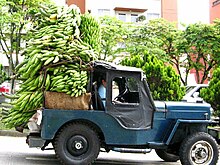Carnival in Colombia
There is documentary evidence that the carnival existed in Colombia in the 17th century[1] and had already caused concern to the colonial authorities, who censored the celebrations, especially in the main centers of power such as Cartagena, Bogotá and Popayán.
The carnival, therefore, continued its evolution and re-interpretation in the small and at that time unimportant towns where celebrations did not offend the ruling elites.
In modern times, there have been attempts to introduce the carnival in the capital, Bogotá, in the early 20th century, but it has always failed to gain the approval of authorities.
By 1887, the celebration had reached to certain social spheres and acquired a high level of refinement, and people started using costumes and masks.
During the 1930s the national government and the council of Bogotá suspended the carnival due to disorders caused by alcohol consumption.
The objective of the new Carnival was to promote a collective atmosphere of fellowship and to celebrate life, creative expression, and enjoyment.


